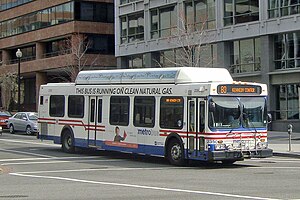Compressed natural gas (CNG)
Natural gas vehicle
High-pressure compressed natural gas, mainly composed of methane, that is used to fuel normal combustion engines instead of gasoline. Combustion of methane produces the least amount of CO2 of all fossil fuels. Gasoline cars can be retrofitted to CNG and become bifuelNatural gas vehicles (NGVs) as the gasoline tank is kept. The driver can switch between CNG and gasoline during operation. Natural gas vehicles (NGVs) are popular in regions or countries where natural gas is abundant. Widespread use began in the Po River Valley of Italy, and later became very popular in New Zealand by the eighties, though its use has declined.[87]
As of December 2012, there were 17.8 million natural gas vehicles worldwide, led by Iran with 3.30 million, followed by Pakistan (2.79 million), Argentina (2.29 million), Brazil (1.75 million), China (1.58 million) andIndia (1.5 million).[9] As of 2010, the Asia-Pacific region led the global market with a share of 54%.[88] In Europe they are popular in Italy (730,000), Ukraine (200,000), Armenia (101,352), Russia (100,000) andGermany (91,500),[88] and they are becoming more so as various manufacturers produce factory made cars, buses, vans and heavy vehicles.[86] In the United States CNG powered buses are the favorite choice of several public transit agencies, with an estimated CNG bus fleet of some 130,000.[89] Other countries where CNG-powered buses are popular include India, Australia, Argentina, and Germany.[87]
CNG vehicles are common in South America, where these vehicles are mainly used as taxicabs in main cities of Argentina and Brazil. Normally, standard gasoline vehicles are retrofitted in specialized shops, which involve installing the gas cylinder in the trunk and the CNG injection system and electronics. The Brazilian GNV fleet is concentrated in the cities of Rio de Janeiro and São Paulo.[90] Pike Research reports that almost 90% of NGVs in Latin America have bi-fuel engines, allowing these vehicles to run on either gasoline or CNG.[91]
In 2006 the Brazilian subsidiary of FIAT introduced the Fiat Siena Tetra fuel, a four-fuel car developed under Magneti Marelli of Fiat Brazil.[92][93] This automobile can run on 100% ethanol (E100), E25 (Brazil's normal ethanol gasoline blend), pure gasoline (not available in Brazil), and natural gas, and switches from the gasoline-ethanol blend to CNG automatically, depending on the power required by road conditions.[94] Other existing option is to retrofit an ethanol flexible-fuel vehicle to add a natural gas tank and the corresponding injection system. Some taxicabs in São Paulo and Rio de Janeiro, Brazil, run on this option, allowing the user to choose among three fuels (E25, E100 and CNG) according to current market prices at the pump. Vehicles with this adaptation are known in Brazil as "tri-fuel" cars


No comments:
Post a Comment